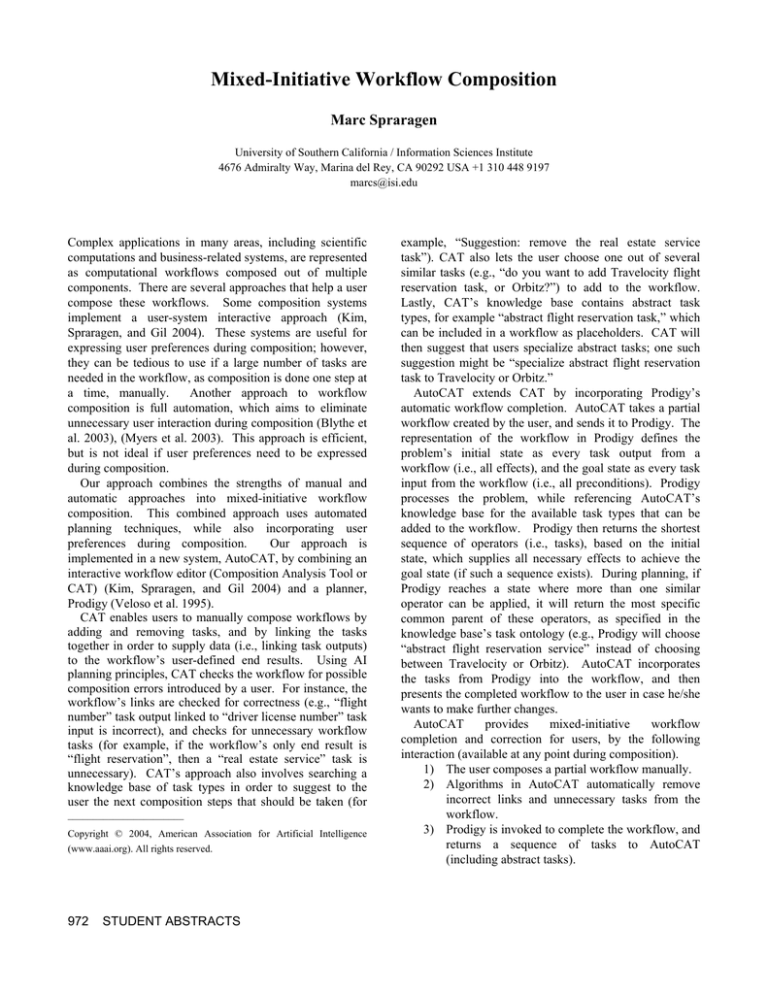
Mixed-Initiative Workflow Composition
Marc Spraragen
University of Southern California / Information Sciences Institute
4676 Admiralty Way, Marina del Rey, CA 90292 USA +1 310 448 9197
marcs@isi.edu
Complex applications in many areas, including scientific
computations and business-related systems, are represented
as computational workflows composed out of multiple
components. There are several approaches that help a user
compose these workflows. Some composition systems
implement a user-system interactive approach (Kim,
Spraragen, and Gil 2004). These systems are useful for
expressing user preferences during composition; however,
they can be tedious to use if a large number of tasks are
needed in the workflow, as composition is done one step at
a time, manually.
Another approach to workflow
composition is full automation, which aims to eliminate
unnecessary user interaction during composition (Blythe et
al. 2003), (Myers et al. 2003). This approach is efficient,
but is not ideal if user preferences need to be expressed
during composition.
Our approach combines the strengths of manual and
automatic approaches into mixed-initiative workflow
composition. This combined approach uses automated
planning techniques, while also incorporating user
preferences during composition.
Our approach is
implemented in a new system, AutoCAT, by combining an
interactive workflow editor (Composition Analysis Tool or
CAT) (Kim, Spraragen, and Gil 2004) and a planner,
Prodigy (Veloso et al. 1995).
CAT enables users to manually compose workflows by
adding and removing tasks, and by linking the tasks
together in order to supply data (i.e., linking task outputs)
to the workflow’s user-defined end results. Using AI
planning principles, CAT checks the workflow for possible
composition errors introduced by a user. For instance, the
workflow’s links are checked for correctness (e.g., “flight
number” task output linked to “driver license number” task
input is incorrect), and checks for unnecessary workflow
tasks (for example, if the workflow’s only end result is
“flight reservation”, then a “real estate service” task is
unnecessary). CAT’s approach also involves searching a
knowledge base of task types in order to suggest to the
user the next composition steps that should be taken (for
_______________________
Copyright © 2004, American Association for Artificial Intelligence
(www.aaai.org). All rights reserved.
972
STUDENT ABSTRACTS
example, “Suggestion: remove the real estate service
task”). CAT also lets the user choose one out of several
similar tasks (e.g., “do you want to add Travelocity flight
reservation task, or Orbitz?”) to add to the workflow.
Lastly, CAT’s knowledge base contains abstract task
types, for example “abstract flight reservation task,” which
can be included in a workflow as placeholders. CAT will
then suggest that users specialize abstract tasks; one such
suggestion might be “specialize abstract flight reservation
task to Travelocity or Orbitz.”
AutoCAT extends CAT by incorporating Prodigy’s
automatic workflow completion. AutoCAT takes a partial
workflow created by the user, and sends it to Prodigy. The
representation of the workflow in Prodigy defines the
problem’s initial state as every task output from a
workflow (i.e., all effects), and the goal state as every task
input from the workflow (i.e., all preconditions). Prodigy
processes the problem, while referencing AutoCAT’s
knowledge base for the available task types that can be
added to the workflow. Prodigy then returns the shortest
sequence of operators (i.e., tasks), based on the initial
state, which supplies all necessary effects to achieve the
goal state (if such a sequence exists). During planning, if
Prodigy reaches a state where more than one similar
operator can be applied, it will return the most specific
common parent of these operators, as specified in the
knowledge base’s task ontology (e.g., Prodigy will choose
“abstract flight reservation service” instead of choosing
between Travelocity or Orbitz). AutoCAT incorporates
the tasks from Prodigy into the workflow, and then
presents the completed workflow to the user in case he/she
wants to make further changes.
AutoCAT
provides
mixed-initiative
workflow
completion and correction for users, by the following
interaction (available at any point during composition).
1) The user composes a partial workflow manually.
2) Algorithms in AutoCAT automatically remove
incorrect links and unnecessary tasks from the
workflow.
3) Prodigy is invoked to complete the workflow, and
returns a sequence of tasks to AutoCAT
(including abstract tasks).
4) AutoCAT formulates suggestion choices for
specializing the abstract tasks.
5) AutoCAT returns the completed workflow, and
suggestions, to the user.
6) The user applies suggestions or further composes
the workflow manually.
The work outlined above demonstrates how mixedinitiative composition can help users compose workflows.
An existing system, PASSAT, has been successful in a
similar mixed-initiative approach using hierarchical task
network (HTN) planning models (Myers et al. 2003),
while AutoCAT uses operator-based planning models
instead of HTN. Our future work will include user tests of
AutoCAT. We will compare these results with results
from previous and future user evaluations of CAT, in part
to analyze AutoCAT’s efficiency and user-friendliness
with respect to CAT.
References
Blythe, J., et al. 2003. The Role of Planning in Grid Computing.
In Proceedings of the Thirteenth International Conference on
Automated Planning and Scheduling, 153-163. Menlo Park,
Calif.: AAAI Press.
Kim, J., Spraragen, M., and Gil, Y. 2004. An intelligent assistant
for interactive workflow composition. In Proceedings of the
Ninth International Conference on Intelligent User Interfaces,
125-131. New York, New York: ACM Press.
Myers, K., et al. 2003. A Mixed-initiative Framework for Robust
Plan Sketching. In Proceedings of the Thirteenth International
Conference on Automated Planning and Scheduling, 256-266.
Menlo Park, Calif.: AAAI Press.
Veloso, M., et al. 1995. Integrating Planning and Learning: The
PRODIGY Architecture. Journal of Theoretical and
Experimental Artificial Intelligence, 7(1):81-120.
STUDENT ABSTRACTS 973





